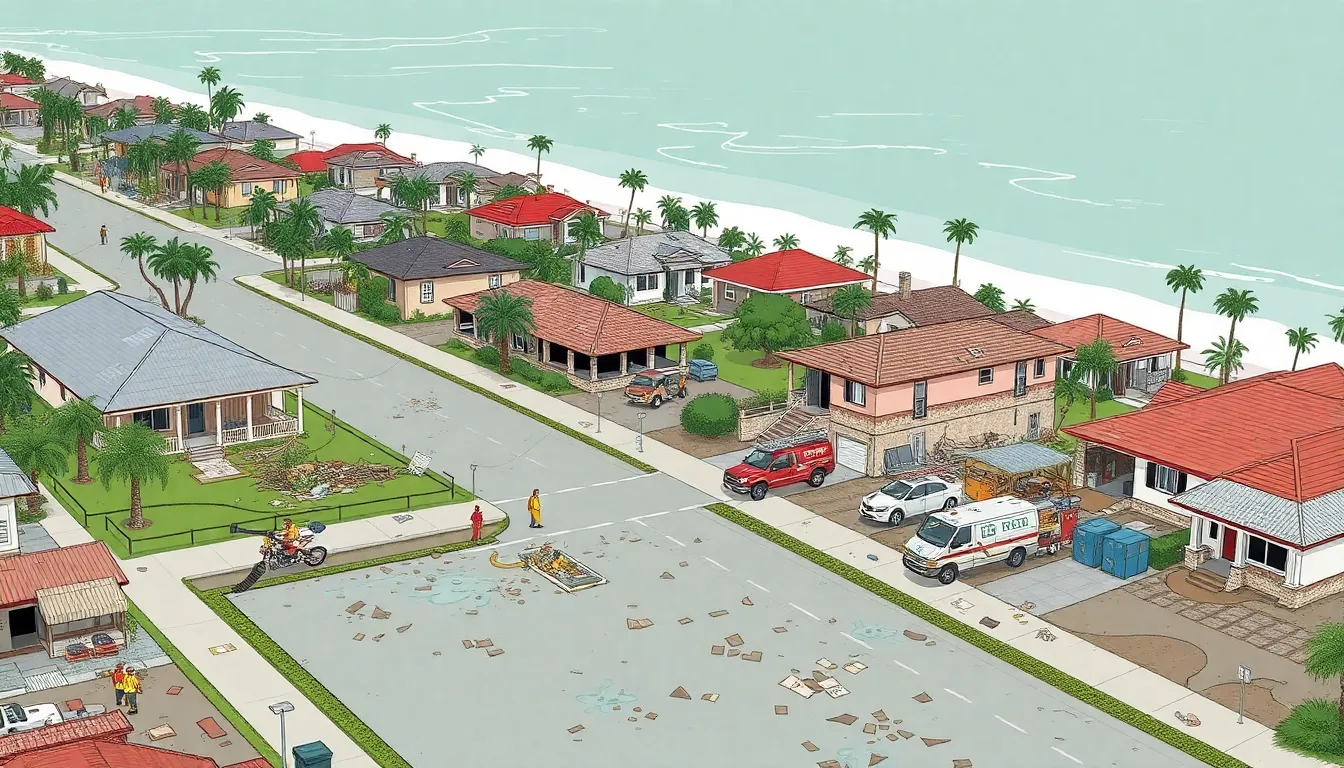When disaster strikes, the impact can be felt far and wide, and the aftermath often leaves people searching for answers. Enter Hurricane Helene, a storm that didn’t just blow through but left a trail of destruction that raised eyebrows and questions alike. As communities grappled with the chaos, the death toll became a stark reminder of nature’s fury.
Table of Contents
ToggleOverview of Helene
Hurricane Helene formed in September 2018, impacting several states along the eastern coast of the United States. The storm generated high winds, heavy rainfall, and flooding, affecting millions. Authorities reported substantial damage, particularly in North Carolina, where some areas experienced extensive destruction.
The death toll resulting from Helene reached a significant number. Fatalities occurred in states like Florida, South Carolina, and Virginia. Rescue teams faced challenges due to debris and adverse weather conditions, complicating recovery efforts. Several communities implemented emergency protocols to safeguard residents during the storm.
Insurance claims surged post-Helene, with estimated losses in the billions. Financial repercussions affected both individuals and businesses in severely impacted areas. Schools and public services struggled to resume normal operations as repairs progressed.
Experts indicated that Helene’s trajectory and intensity could be attributed to shifting climate patterns. Increased hurricane activity correlates with warmer sea temperatures, leading to more severe storms. Meteorologists continue to study Helene’s effects, gathering data to inform future preparedness strategies.
Resilience of affected communities grew stronger as residents united to rebuild. Local organizations mobilized to provide aid and resources, highlighting the spirit of cooperation amid adversity. Dedication to overcoming the challenges posed by Helene remains evident in the ongoing recovery efforts.
States Affected by Helene

Hurricane Helene caused significant destruction across several states, with varying degrees of impact and loss of life. The aftermath left communities grappling with the effects of the storm.
State 1: Florida
Florida experienced severe winds and heavy rainfall from Hurricane Helene. The storm’s impact led to a recorded death toll of 5 individuals. Damage assessments highlighted widespread flooding across coastal areas, especially in the Panhandle region. Rescue efforts faced challenges due to fallen trees and power lines blocking roads. Residents reported extensive property damage, resulting in thousands of insurance claims and financial hardship. Local authorities mobilized to restore essential services, emphasizing community resilience in the rebuilding process.
State 2: South Carolina
South Carolina experienced significant flooding and strong winds due to Helene. The state recorded 3 fatalities during the storm. Coastal communities reported damage to infrastructure and homes, particularly in the low-lying areas. Emergency response teams worked tirelessly to assist those affected. Many residents sought shelter as rising water levels threatened safety. Recovery efforts were complicated by debris removal, and insurance claims surged across the state. Community organizations rallied support, offering resources to those without homes.
State 3: Virginia
Virginia felt the effects of Hurricane Helene through intense rainfall and strong gusts. The state saw 2 confirmed deaths attributed to the storm. Significant flooding occurred, resulting in road closures and disrupted transportation. Local governments implemented emergency measures to protect residents. Rescue teams provided aid, and many people required assistance evacuating their homes. The aftermath focused on restoring services and assessing damage. Collaborative efforts between state agencies and non-profit organizations supported recovery initiatives, helping reinstate normalcy in affected areas.
Analysis of Death Toll
Hurricane Helene’s impact varied significantly across states, highlighting contributing factors to the death toll. Various elements influenced fatalities, including location characteristics, population density, and preparedness levels. Areas like North Carolina experienced severe flooding due to heavy rainfall, escalating risks in already vulnerable communities. In contrast, Florida’s fatalities stemmed from high winds and infrastructure failures, amplifying the danger. Additionally, response times for emergency services were hampered by debris, complicating rescues in multiple states.
Comparison of Helene’s death toll with other hurricanes shows differing impacts across regions. For instance, Hurricane Florence caused 53 deaths in 2018, primarily due to flooding, while Hurricane Katrina in 2005 resulted in over 1,800 fatalities. Helene’s toll, at ten confirmed deaths, remains considerably lower but still underscores the threat posed by hurricane activity. While fatalities may appear minimal, the repercussions linger for communities striving to recover.
Resources and Assistance
Authorities and community organizations provided various resources and assistance after Hurricane Helene. This support addressed immediate needs and laid the groundwork for long-term recovery.
Government Response
State and federal agencies mobilized quickly to deliver aid. Programs for disaster relief offered immediate help, such as financial assistance and temporary housing. FEMA played a crucial role, facilitating recovery efforts in the hardest-hit areas. In North Carolina, local governments collaborated with federal officials to establish recovery centers. Emergency services focused on restoring essential infrastructure and providing medical care. Those impacted received crucial supplies including food and water. Proactive measures aimed to address the lingering aftermath of the storm, ensuring residents had access to resources.
Community Support
Local organizations rallied to support affected families. Grassroots efforts emerged, facilitating food drives and donation centers. Volunteers provided essential help in cleanup and recovery tasks. Neighborhood associations coordinated with larger agencies to maximize assistance reach. Mental health services offered counseling to those coping with trauma from the storm. Efforts included workshops and outreach programs to help residents rebuild. Community spirit thrived, showcasing resilience in response to challenges. These initiatives fostered cohesion, providing hope amid adversity.
The aftermath of Hurricane Helene serves as a stark reminder of nature’s unpredictable power. While the death toll was lower compared to other significant storms, the impact on communities was profound. Recovery efforts highlighted the importance of preparedness and swift response from both local and federal agencies.
As communities continue to rebuild, the resilience and unity displayed by residents shine through. Ongoing support from organizations and volunteers plays a crucial role in helping affected areas regain stability. The lessons learned from Helene will undoubtedly inform future disaster preparedness and response strategies, ensuring that communities are better equipped to face similar challenges ahead.




